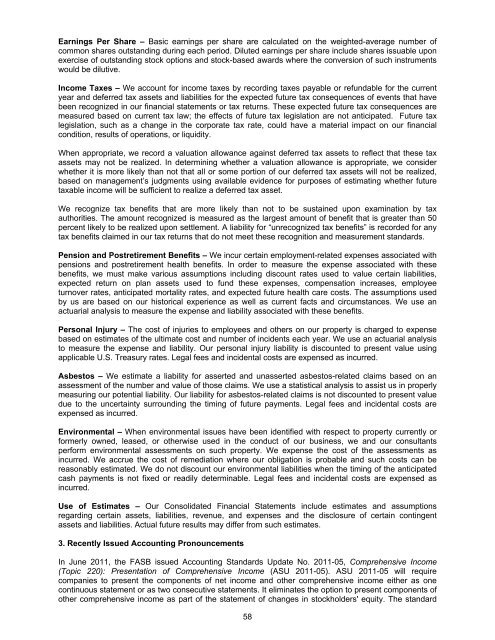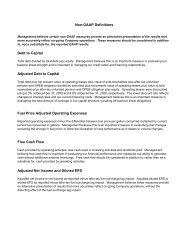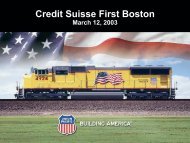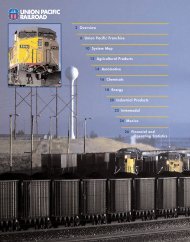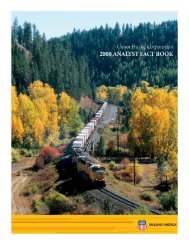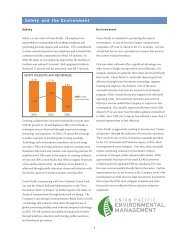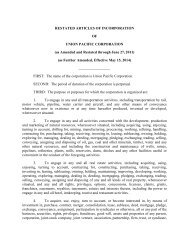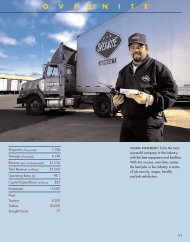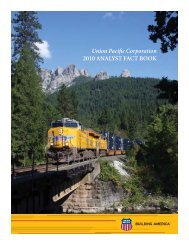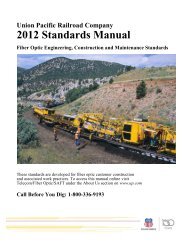Form 10-K - Union Pacific
Form 10-K - Union Pacific
Form 10-K - Union Pacific
You also want an ePaper? Increase the reach of your titles
YUMPU automatically turns print PDFs into web optimized ePapers that Google loves.
Earnings Per Share – Basic earnings per share are calculated on the weighted-average number of<br />
common shares outstanding during each period. Diluted earnings per share include shares issuable upon<br />
exercise of outstanding stock options and stock-based awards where the conversion of such instruments<br />
would be dilutive.<br />
Income Taxes – We account for income taxes by recording taxes payable or refundable for the current<br />
year and deferred tax assets and liabilities for the expected future tax consequences of events that have<br />
been recognized in our financial statements or tax returns. These expected future tax consequences are<br />
measured based on current tax law; the effects of future tax legislation are not anticipated. Future tax<br />
legislation, such as a change in the corporate tax rate, could have a material impact on our financial<br />
condition, results of operations, or liquidity.<br />
When appropriate, we record a valuation allowance against deferred tax assets to reflect that these tax<br />
assets may not be realized. In determining whether a valuation allowance is appropriate, we consider<br />
whether it is more likely than not that all or some portion of our deferred tax assets will not be realized,<br />
based on management’s judgments using available evidence for purposes of estimating whether future<br />
taxable income will be sufficient to realize a deferred tax asset.<br />
We recognize tax benefits that are more likely than not to be sustained upon examination by tax<br />
authorities. The amount recognized is measured as the largest amount of benefit that is greater than 50<br />
percent likely to be realized upon settlement. A liability for “unrecognized tax benefits” is recorded for any<br />
tax benefits claimed in our tax returns that do not meet these recognition and measurement standards.<br />
Pension and Postretirement Benefits – We incur certain employment-related expenses associated with<br />
pensions and postretirement health benefits. In order to measure the expense associated with these<br />
benefits, we must make various assumptions including discount rates used to value certain liabilities,<br />
expected return on plan assets used to fund these expenses, compensation increases, employee<br />
turnover rates, anticipated mortality rates, and expected future health care costs. The assumptions used<br />
by us are based on our historical experience as well as current facts and circumstances. We use an<br />
actuarial analysis to measure the expense and liability associated with these benefits.<br />
Personal Injury – The cost of injuries to employees and others on our property is charged to expense<br />
based on estimates of the ultimate cost and number of incidents each year. We use an actuarial analysis<br />
to measure the expense and liability. Our personal injury liability is discounted to present value using<br />
applicable U.S. Treasury rates. Legal fees and incidental costs are expensed as incurred.<br />
Asbestos – We estimate a liability for asserted and unasserted asbestos-related claims based on an<br />
assessment of the number and value of those claims. We use a statistical analysis to assist us in properly<br />
measuring our potential liability. Our liability for asbestos-related claims is not discounted to present value<br />
due to the uncertainty surrounding the timing of future payments. Legal fees and incidental costs are<br />
expensed as incurred.<br />
Environmental – When environmental issues have been identified with respect to property currently or<br />
formerly owned, leased, or otherwise used in the conduct of our business, we and our consultants<br />
perform environmental assessments on such property. We expense the cost of the assessments as<br />
incurred. We accrue the cost of remediation where our obligation is probable and such costs can be<br />
reasonably estimated. We do not discount our environmental liabilities when the timing of the anticipated<br />
cash payments is not fixed or readily determinable. Legal fees and incidental costs are expensed as<br />
incurred.<br />
Use of Estimates – Our Consolidated Financial Statements include estimates and assumptions<br />
regarding certain assets, liabilities, revenue, and expenses and the disclosure of certain contingent<br />
assets and liabilities. Actual future results may differ from such estimates.<br />
3. Recently Issued Accounting Pronouncements<br />
In June 2011, the FASB issued Accounting Standards Update No. 2011-05, Comprehensive Income<br />
(Topic 220): Presentation of Comprehensive Income (ASU 2011-05). ASU 2011-05 will require<br />
companies to present the components of net income and other comprehensive income either as one<br />
continuous statement or as two consecutive statements. It eliminates the option to present components of<br />
other comprehensive income as part of the statement of changes in stockholders' equity. The standard<br />
58


